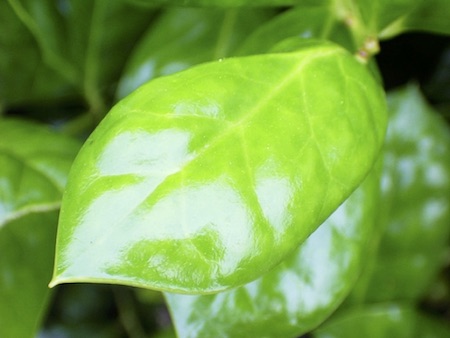Southwest Yard & Garden by Dr. Marisa Thompson
 Figure 1. Some plants are able to thicken the waxy cuticle layer on leaf tissue in response to increased light exposure (photo credit: discutant, flickr.com
Figure 1. Some plants are able to thicken the waxy cuticle layer on leaf tissue in response to increased light exposure (photo credit: discutant, flickr.com
You Can Help Avoid Plant Sunburn
Reprint from June 2010. Written by Dr. Curtis Smith, retired NMSU Extension Horticulture Specialist, with additions by Marisa Thompson
Question:
I took my plants outside for the summer as I had always done in my home in Tennessee before I moved to New Mexico. Within a day, the leaves on many of the plants turned white and then brown. I think I may have killed my houseplants! I know New Mexico is a lot drier than Tennessee, but I watered them well and they died so fast I think there must be another problem.
Answer:
The sunlight is much more intense here in the arid Southwestern U.S. We are at high elevation, and there is little moisture in the air to reduce the intensity of our light—plus, we have much less cloud cover than other parts of the country. You sunburned your plants. Some plants, especially woody plants, may be able to recover and produce new leaves that are better adapted to higher light intensity. Some herbaceous (non-woody) plants may die, and others may sprout from the stems or the base. Be patient to see which can recover.
One thing to try right away is to move your plants to a shady location. Morning sun is good, but by late morning, the light intensity becomes too great for many houseplants. Some trees, like mulberries and catalpa trees, cast too dense a shade for many houseplants, but for others it is perfect. Honeylocust trees cast a lighter shade that is good for houseplants that need more light. Other trees also make good shade. Visit http://aces.nmsu.edu/pubs/_h/H426/welcome.html for the NMSU Extension Guide H-426 “Shade Trees for New Mexico” (también en español, “Árboles de Sombra para Nuevo México”:
http://aces.nmsu.edu/pubs/_h/H426_span/welcome.html).
Some houseplants will do well in the shade on the north side of your house, while others will do better on the east side. Move your plants from site to site until you find the right place. Your plants will tell you when you’ve got it right by producing healthy new growth without sunburning. However, move them slowly from shadier to brighter locations, giving them time to adjust as you move them. Remember where you put them so you can put them in the same spot next summer.
In shade, leaves are adapted to be more efficient at utilizing lower levels of light. Therefore, the leaves can be bigger deep in the shady part of the canopy. If you expose shaded leaves to intense sunlight too quickly, like by taking a houseplant outdoors or pruning off outer leaves in a tree canopy, you can expect to see signs of distress, such as sunburn.
In brighter locations, leaves adapt by increasing protection against the higher light levels, but become slightly less efficient. Lowered efficiency does not cause problems until, in the case of a potted plant, you take the plants indoors for the winter, and then the sun-adapted leaves will often fall off and be replaced by shade-adapted leaves under the dimmer light conditions indoors.
Plants have the ability to adapt to different light levels—within limits. Some species are better at adapting than others. They produce “sun leaves” when grown in bright light and "shade leaves" in the shade. Generally speaking, “sun leaves” are more likely to have one or all of the following characteristics compared to “shade leaves” on the same plant: smaller individual leaf area, a more reddish hue, and a thicker or waxier cuticle (the cuticle is the protective outer layer on leaf tissue; Figure 1). There are other differences, but you get the idea.
Vegetable and flower transplants from the nursery often go through this adaptation process as well. Plants grown in humid greenhouses will often have shade leaves and should be gradually adapted to the outdoor conditions. In the garden, they must adapt to increased light, drier air, wind, and sometimes to higher or lower temperatures.
Plants are able to adapt, but they should gradually be acclimated to the new conditions. To do this, put them in a shady, protected location when you first take them home, then gradually move them to brighter, drier, less-protected locations before planting them in the garden. Alternatively, you can build protection around the plants immediately after planting them in the garden. Cover them lightly with old brush from shrub trimming, or place other material on the upwind, sunny side of the plants until they can adapt. Transplanting will be less shocking to the plants if they are given time to adapt to the harsh garden environment.
Send gardening questions to Southwest Yard and Garden - Attn: Dr. Marisa Thompson at desertblooms@nmsu.edu , or at the NM Desert Blooms Facebook page (@NMDesertBlooms)
Please copy your County Extension Agent (http://aces.nmsu.edu/county/) and indicate your county of residence when you submit your question!
For more gardening information, visit the NMSU Extension Horticulture page at Desert Blooms (http://desertblooms.nmsu.edu/) and the NMSU Horticulture Publications page at http://aces.nmsu.edu/pubs/_h/.
Marisa Y. Thompson, Ph.D., is the Extension Horticulture Specialist, in the Department of Extension Plant Sciences at the New Mexico State University Los Lunas Agricultural Science Center, office: 505- 865-7340, ext. 113.